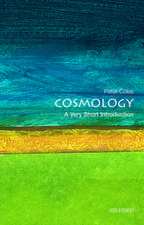Dusty and Dirty Plasmas, Noise, and Chaos in Space and in the Laboratory
Editat de H. Kikuchien Limba Engleză Paperback – 21 oct 2012
Preț: 414.69 lei
Nou
Puncte Express: 622
Preț estimativ în valută:
79.36€ • 82.35$ • 66.33£
79.36€ • 82.35$ • 66.33£
Carte tipărită la comandă
Livrare economică 15-29 martie
Preluare comenzi: 021 569.72.76
Specificații
ISBN-13: 9781461357407
ISBN-10: 1461357403
Pagini: 608
Ilustrații: XV, 591 p.
Dimensiuni: 178 x 254 x 32 mm
Greutate: 1.04 kg
Ediția:1994
Editura: Springer Us
Colecția Springer
Locul publicării:New York, NY, United States
ISBN-10: 1461357403
Pagini: 608
Ilustrații: XV, 591 p.
Dimensiuni: 178 x 254 x 32 mm
Greutate: 1.04 kg
Ediția:1994
Editura: Springer Us
Colecția Springer
Locul publicării:New York, NY, United States
Public țintă
ResearchCuprins
1. Cosmic Dusty Plasmas.- 1.1 Cosmic Dusty Plasmas: Some Recent Results.- 1.2 Parametric Excitation of the Low-Frequency Oscillations in the Dusty plasma of Planetary Rings.- 1.3 Spokes in the Saturn’s Ring as Solutions in Dusty Plasma.- 1.4 Effects of the Charged Dust in a High Energy Electron Beam.- 1.5 Plasma Tail and Dust Tail of Comets.- 1.6 CRRES Plasma Wave Observations during Quiet Times, during Geomagnetic Disturbances, and during Chemical Releases.- 2. Laboratory Dusty Plasmas: Theory and Experiment.- 2.1 Coherent Structures in Low-Temperature Dusty Plasmas.- 2.2 Electron-Free Plasma.- 2.3 Measurement of Electric Carge of Dust in a Plasma.- 2.4 Effects of Intersteiler Neutral Wind on the Structure of the Heliosphere — Laboratory Simulation.- 3. Meteorologico-Electric Environment and EHD.- 3.1 EHD and EHMD Transport Processes in Dusty and Dirty Plasmas.- 3.2 The Mechanism of Electrohydrodynamic Wind Generation in a Lower Atomosphere.- 3.3 Verhulst Dynamics and Fractal Streching of Transition Layer Vorticity.- 3.4 The state of Matter FIELD and Its Property — A New Basic Approach to the Understanding of Terrestrial and Extraterrestrial Electomagnetic Environment.- 4. Self-Organization and Turbulence.- 4.1 Self-Organization Processes in Turbulent Atomosphere and Methods for Their Study.- 4.2 Studying of Helical Turbulence Self-Organization Based on 3D-Generation of Hasegawa-Mima Equation.- 4.3 Quantum Aspects of Self-Organization in Dynamically Random Systems.- 4.4 Self-Organization in Plasmas.- 4.5 Plasma Maser in Turbulent Media.- 4.6 A Statistical Theory of Turbulence.- 4.7 Two-Time Fourier Convolution Theorem and Its Applications.- 5. Lightning Discharges and Laboratory Simulation.- 5.1 A New Model of Lightning.- 5.2 Acoustic -based Real TimeReconstruction of Lightning Discharge Channel Using Parallel Processing.- 5.3 Forecast of Winter Thundercloud of by Frequency Analysis of Atomospheric Pressure.- 5.4 Fundamental Experiments Concerning Laser Triggered Lightning.- 6. Atmospheric Electricity and Noise.- 6.1 Jet Stream Electrodynamics.- 6.2 Fading Patterns on on the Sonagram of Atomospherics.- 6.3 Mobility Distributions and Mass Distributions of Atomospheric Ions near the Ground.- 7. Magnetospheric Noise and Pulsations.- 7.1 Local Time Dependence of Wave Characteristics of Pi2 Pulsations Observed at Synchronous Orbit.- 7.2 Solar Cycle Variation of Local Time Dependence in Frequency of Occurrence of Pi2.- 7.3 Magnetospheric VLF Waves Observed by DE-1.- 7.4 The Experimental Results of triggering Chorus Emissions from Monochromatic Wave Components in the Hiss Band in the Outer Magnetosphere.- 7.5 A New Direction Finding Method of Magnetospheric VLF/ELF Radio Waves Using the Linear Regularization and Generalized Cross Validation.- 8. Planetary and Solar Noise and Plasmas.- 8.1 Non-Auroral Lights on Jupiter’s Dark Side.- 8.2 Venus Plasma Noise Studies: A Lesson from Flawed Analysis and Intepretation.- 8.3 Beaming Geometry of the Io-Related Decametric Radiation.- 8.4 Yohkoh Observations from the Onset of Several Flares.- 8.5 Plasma Corona and Dust Corona of the Sun.- 9. Galactic Noise and Plasmas.- 9.1 An Overview of Observations with X-Ray Astronomy Satellite GINGA.- 9.2 X-Ray Emission from Compact X-Ray Sources and the Dust near or surrounding the Sources.- 9.3 A Systematic Study of Dense Cloud Cores and Star Formation.- 10. Fluctuations, Chaos, Reconnection, and Acceleration.- 10.1 Chaos in Plasmas: A Case Study in Thermionic Discharges.- 10.2 Fluctuational and Intermittent Chaos: Wave-Turbulent andWave-Fluctuation Amplification Processes in Geophysical Hydrodynamics.- 10.3 Electric Reconnection and Chaos in Dusty and Dirty Plasmas.- 10.4 Pre-Earthquake Ionospheric Effects and their Possible Mechanisms.- 10.5 Plasma-Based Particle Acceleration.- 11. Ball Lightning and Microwave Discharges.- 11.1 A Novel Method to Induce Atmospheric Microwave Discharges by Moderate Powers.- 11.2 Nature of Fireballs Produced by Microwave Interference.- 11.3 Considerations of Internal Mechanism of Ball Lightning — Based on the simulation experiment of damages on the tree which were seemed to be produced by ball lightning.



















